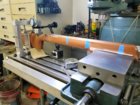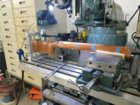Install the app
How to install the app on iOS
Follow along with the video below to see how to install our site as a web app on your home screen.
Note: This feature may not be available in some browsers.
- Home
- Forums
- Q&A: Gear, Gun Projects, and Gunsmithing
- Gun Project Questions & Gunsmithing
- Advanced Gunsmithing & Engineering
You are using an out of date browser. It may not display this or other websites correctly.
You should upgrade or use an alternative browser.
You should upgrade or use an alternative browser.
Inletting stocks
- Thread starter Jimbob
- Start date
Dusty Stevens
Shiner
Old belts cut to go in the vise jaws and those little red jack stands work for me
hpshooter
Gold $$ Contributor
Pad the mill vise jaws with pieces of 3/8" thick runner conveyor belt. Clamp stock in the general vicinity of the recoil lug. Support toe and fore end with machinist jacks or wooden wedges.
Check set up frequently if making heavy cuts, vibration can loosen things up.
Check set up frequently if making heavy cuts, vibration can loosen things up.
mikeeg02
Michael Glantz
@gunnermhr just built a nice setup for his mill.
I used it but heres a couple pictures he sent me. He glued leather to the aluminum push bars. Do-all type vice for the forearm.


I used it but heres a couple pictures he sent me. He glued leather to the aluminum push bars. Do-all type vice for the forearm.


Alex Wheeler
Site $$ Sponsor
I inlet stocks every week, I do full inlets on almost every build including the sporters. I find that tall jaws in your vise with a tall angle plate for the butt and an assortment of shims and clamps is the fastest and most versatile. I can get a stock in the Bridgeport trammed and leveled out in a few minutes. The more you do the faster you will get.Hows everybody holding stocks to inlet them
Lets see some pictures of what your using to hold them on a mill table other than a vice
mikeeg02
Michael Glantz
If it's a wood stock made on a duplicator, they don't come out quite perfect. So you'll have to decide what's most visually appealing to you. If it's a flat top, and it's mostly flat you can average that, or you can level up the surface where the fore-end is and go off of that. Either way, you'll likely find you're going to end up truing it all up all the surfaces with the mill. Once you have it in place I've found its best to always make sure you level and square everything you can with it in the position it's in. That way you can flip it over and have a flat reference. Some of the decision you make will be determined by where you have the most "excess" wood that you can mill down and make true to everything else.
Once you've put it in, trued up everything you can, you can put the action screw holes in. And then cut out for the action and barrel channel. Once you've finished inletting, you can flip it over, and since the top will be flat, you will have your reference, and you'll just need to tram in the action screw holes you drilled for your left and right. Now you can make the fore-arm perfectly parallel with your action and each other. Its also a good time to true up the bottom of the forearm, and if you're doing a tooley style you can flatten out the tail and make everything true.
I realized this is getting long. A lot of it just comes down to personal preference, and experiences learned from mistakes made, or "better ways" found by doing so. If you have someone nearby who has done it, that can help. Or if you'd like I can talk you through some of how I like to do it. As sometimes its a little easier than typing it all out. If you'd like, pm me your phone number.
Hope some of that helps.
Once you've put it in, trued up everything you can, you can put the action screw holes in. And then cut out for the action and barrel channel. Once you've finished inletting, you can flip it over, and since the top will be flat, you will have your reference, and you'll just need to tram in the action screw holes you drilled for your left and right. Now you can make the fore-arm perfectly parallel with your action and each other. Its also a good time to true up the bottom of the forearm, and if you're doing a tooley style you can flatten out the tail and make everything true.
I realized this is getting long. A lot of it just comes down to personal preference, and experiences learned from mistakes made, or "better ways" found by doing so. If you have someone nearby who has done it, that can help. Or if you'd like I can talk you through some of how I like to do it. As sometimes its a little easier than typing it all out. If you'd like, pm me your phone number.
Hope some of that helps.
Thank you Mikeeg02If it's a wood stock made on a duplicator, they don't come out quite perfect. So you'll have to decide what's most visually appealing to you. If it's a flat top, and it's mostly flat you can average that, or you can level up the surface where the fore-end is and go off of that. Either way, you'll likely find you're going to end up truing it all up all the surfaces with the mill. Once you have it in place I've found its best to always make sure you level and square everything you can with it in the position it's in. That way you can flip it over and have a flat reference. Some of the decision you make will be determined by where you have the most "excess" wood that you can mill down and make true to everything else.
Once you've put it in, trued up everything you can, you can put the action screw holes in. And then cut out for the action and barrel channel. Once you've finished inletting, you can flip it over, and since the top will be flat, you will have your reference, and you'll just need to tram in the action screw holes you drilled for your left and right. Now you can make the fore-arm perfectly parallel with your action and each other. Its also a good time to true up the bottom of the forearm, and if you're doing a tooley style you can flatten out the tail and make everything true.
I realized this is getting long. A lot of it just comes down to personal preference, and experiences learned from mistakes made, or "better ways" found by doing so. If you have someone nearby who has done it, that can help. Or if you'd like I can talk you through some of how I like to do it. As sometimes its a little easier than typing it all out. If you'd like, pm me your phone number.
Hope some of that helps.
I understand how and where to hold onto, but where would you say is the single most important surface to indicate flat? Bottom of forend?
I cannot speak for other stock makers or gunsmiths here. I can only tell you what/how I do stocks from a rectangular blank.
When I have a blank, I use a couple of mill vises to hold the blank, with some 90 degree cast angle plates and some other padded hardware to give me support in later operations (like milling the bottom of the foreend and the toe line). I try to get what will be the left side of the stock to be a true (flat) surface. This can be done with a planer or a Saf-T-Planer in a trammed mill if you have enough mill table space and X movement on your mill. I'm not taking off much at all - maybe 0.025" to get the left side completely flat. This will vary according to who is cutting your blank. I have only a couple of suppliers of blanks, and they send me pretty consistent blanks.
Then I'll put the stock blank into a couple of mill vises on my mill, with what will be the left side of the stock up against the fixed jaw in the vises, a round dowel between the moving jaw and the stock blank's right side. Then I'll run a Saf-T-Planer across what will be the top of the stock so I have a top that's perpendicular to the left side. Then I take all measurements off the top or left, and I start by drilling the front screw hole, then milling the barrel channel and action area. All measurements I take then are from the top line of the stock and the left side (for a right-handed stock).
Again, this might not work for other people. I have methods that work for me. Stock making isn't a process that is cast in stone for everyone the same way, every single time. The grain changes, the wood changes, the particulars of the action/barrel change. I cannot possibly give recommendations that work for everyone, never mind on every gun/stock. I've done stocks both with a Bridgeport-style mill and almost completely on the bench using rasps, files and saws. You need to find what works for you. Ask around, get ideas, try them out. Until you've done a half-dozen stocks or so, you'll feel like you don't have "what works" for you. After my 8th stock or so, it started gelling for me what works, what doesn't, what takes more effort than it is worth, etc. Sorry I can't give you more concrete information than this.
Similar threads
- Replies
- 160
- Views
- 10,007
- Replies
- 13
- Views
- 3,240
- Replies
- 9
- Views
- 6,654
Upgrades & Donations
This Forum's expenses are primarily paid by member contributions. You can upgrade your Forum membership in seconds. Gold and Silver members get unlimited FREE classifieds for one year. Gold members can upload custom avatars.

Click Upgrade Membership Button ABOVE to get Gold or Silver Status.
You can also donate any amount, large or small, with the button below. Include your Forum Name in the PayPal Notes field.
To DONATE by CHECK, or make a recurring donation, CLICK HERE to learn how.

Click Upgrade Membership Button ABOVE to get Gold or Silver Status.
You can also donate any amount, large or small, with the button below. Include your Forum Name in the PayPal Notes field.
To DONATE by CHECK, or make a recurring donation, CLICK HERE to learn how.









